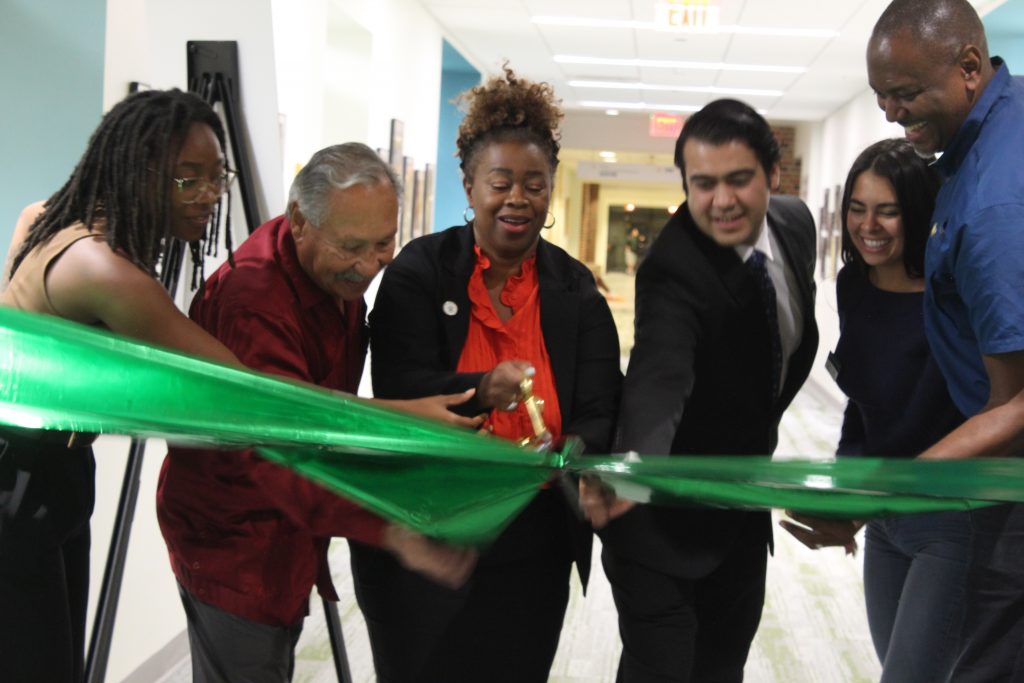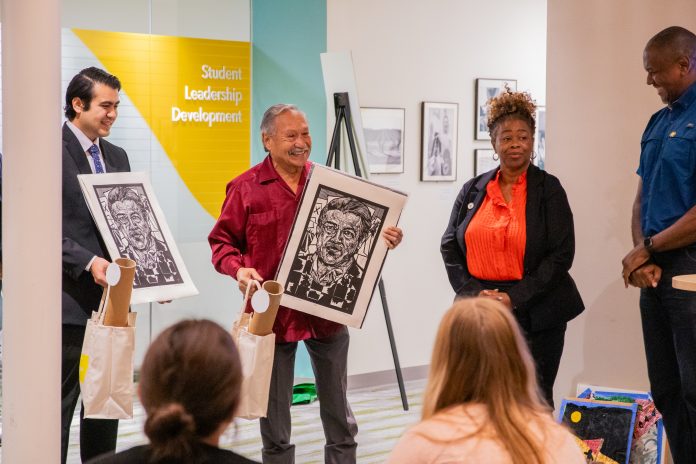Friday, Sept. 22, the Center for Student Diversity hosted the grand opening of a photography exhibition documenting the life of Cesar Chavez using photos from the National Chavez Center. The exhibit will be open and available to members of the College of William and Mary community at the Slice in Sadler Center from Sept. 22 until Oct. 30.
Chavez, a Mexican-American civil rights activist who fought for the rights of farm workers and other marginalized groups and improved working conditions, established the United Farm Workers, or UFW, in 1962 to better advocate for these rights. As a civil rights advocate, he also represented the Latinx population, tying in with the College’s celebration of Latinx Heritage Month, which started on Sept. 15 and will continue until Oct. 15.
“By bringing the exhibit from the National Chavez Center in California, this is an opportunity to celebrate and look at the history of a civil rights giant, so that’s why we’re so excited to have this event here with us to October 30,” Assistant Dean and Director of the Center for Student Diversity Kimberly Weatherly said.
At the exhibit, former President of the UFW Arturo Rodriguez, who joined the union in 1973, discussed Chavez’s work and the values the organization holds. As farmers suffered precarious working conditions, such as no bathrooms, no minimum wage rights and no determined work hours, Chavez, saw this firsthand and began to organize boycotts and created the motto, ¡Si Se Puede! (Yes, It’s Possible)!
“I think what’s important for people to know is that Cesar Chavez was just a common person, just like any of us, but he had deep beliefs, he had strong beliefs that any of us could be Cesar Chavezes, man or woman, that we can do the unthinkable and we could do the unexpected if we really are determined and committed and willing to put in the energy that’s required to make it happen,” Rodriguez said. “All of us have the capacity to do that, and I think that’s the biggest thing to remember about Caesar. He was just a common person who went to the eighth grade but had a tremendous amount of determination and will to be able to change a system that systematically discriminated and abused people and exploited people for generations.”
The photographs catalog the series of events that led to the eventual unionization of farm workers, and they communicate the UFW’s perseverance, which led the group gaining the rights they deserved. In 1966, farmers led by Chavez marched 340 miles from Delano to Sacramento in California to protest their deplorable working conditions. With 10,000 people waiting to greet them at the end, this march created immense awareness across the country in support of the union. Another of the many events portrayed in the exhibit is the first ever boycott of grapes that Chavez led in 1975. In this strike, Chavez and his supporters showed that it was only by hurting the economic bottom line of the growers that change could be enacted.

This is exactly what occurred; about 17 million consumers stopped buying grapes to demonstrate their support, finally forcing new laws and contracts to be drawn up to improve the conditions in the fields.
“Those images are going to show and demonstrate that this is what workers are willing to go through because of the fact that they had this strong belief in ¡Si Se Puede!” Rodriguez said.
Rodriguez contextualized the internal debate surrounding these types of sacrifices for the workers on strike.
“You see the sacrifice that the workers made in the strike lines and the fact that they decided this was the right thing to do even though it was going to have a real negative impact on their families,” Rodriguez said.
The exhibition itself was curated by Director of Engagement and Distinguished Artist in Residence Steve Prince, who used various photographs to document Chavez’s lifelong dedication to the movement. Prince noted that these black-and-white pictures emphasize both the arduous struggles and incredible achievements of the farm workers.
“So much has happened with this particular movement, many people have forgotten or don’t know about it,” Prince said. “So this is a wonderful opportunity for us to enlighten people about what took place back in the ‘60s and ‘70s and right here in our nation, but also what is continuing, what is still going on in our nation on multiple levels.”
Prince, who says he focuses on the idea of remembering in his art, further elaborated on the importance of using art to fill in gaps of memory and think more critically.
“Too often we get caught up in the space of just having fun and having a good time and living in a kind of peaceful bubble, and the visual arts help us to see,” Prince said. “I think the artist’s role is to help us not only to remember. The artist’s role is to challenge us to see deeper.”
Several students also attended the event, enthusiastic to celebrate the work of the famous civil rights activist and to reflect on the welcoming culture present at the College.
“William and Mary is a community of inclusive individuals who are excited to learn about other cultures, and I think this presentation is a wonderful way to show respect to those who come before us,” Camille Coughlan ’27 said.
As the College continues to celebrate Latinx Heritage Month with this exhibition alongside other programming, it will continue to highlight and memorialize the contributions that Latinx individuals like Chavez have made throughout history.
“Latinx Heritage Month is a celebration of all the contributions that Latinx heritage people have made throughout the decades,” Weatherly said. “It’s an opportunity for us to learn culturally about another culture.”

